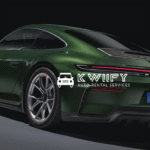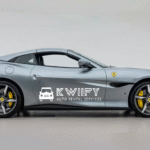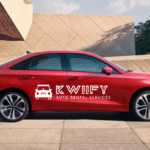

2025 Porsche 911 Specs, Review and Price
The 2025 Porsche 911, codenamed 992.2, is a testament to Porsche’s mastery of blending tradition with innovation. As the latest evolution of the iconic 911 lineup, this facelifted model introduces subtle styling updates, enhanced performance, and a groundbreaking hybrid powertrain for the GTS trim. With a legacy spanning over six decades, the 2025 Porsche 911 continues to set the benchmark for sports cars, offering a thrilling yet practical driving experience. In this 1500-word review, we explore every aspect of the 2025 Porsche 911, from its design and performance to its interior, technology, and specifications. Whether you’re a Porsche enthusiast or a potential buyer, this SEO-optimized guide covers all the essential subtopics to help you understand what makes the 2025 911 a standout.
Overview of the 2025 Porsche 911
The 2025 Porsche 911 marks the mid-cycle refresh of the 992 generation, bringing refined aesthetics, upgraded powertrains, and advanced technology. Known internally as the 992.2, this model builds on the success of the 992.1 (introduced in 2020) while introducing a T-Hybrid system in the GTS trim, a first for the road-going 911. Available in coupe, cabriolet, and Targa body styles, the 911 lineup includes the Carrera, Carrera T, Carrera S, Carrera 4S, GTS, and the high-performance Turbo and GT3 variants, which we’ll cover where relevant. Starting at $122,095 for the base Carrera, the 911 remains a premium sports car that balances everyday usability with track-ready performance.
2025 Porsche 911 Specifications
The 2025 Porsche 911 offers a range of trims with distinct specifications, catering to various driving preferences. Below is a detailed breakdown of key specs for the primary models:
-
Carrera:
-
Engine: 3.0L twin-turbo flat-six
-
Power: 388 hp @ 6,500 rpm
-
Torque: 331 lb-ft @ 1,950–5,000 rpm
-
Transmission: 8-speed PDK dual-clutch
-
0-60 mph: 3.7 seconds (with Sport Chrono)
-
Top Speed: 183 mph
-
Curb Weight: 3,356 lbs (coupe)
-
Fuel Economy: 18 mpg city / 25 mpg highway
-
Price: $122,095
-
-
Carrera T:
-
Engine: 3.0L twin-turbo flat-six
-
Power: 388 hp @ 6,500 rpm
-
Torque: 331 lb-ft @ 1,950–5,000 rpm
-
Transmission: 6-speed manual
-
0-60 mph: 4.5 seconds
-
Top Speed: 182 mph
-
Curb Weight: 3,316 lbs (coupe)
-
Fuel Economy: 17 mpg city / 24 mpg highway
-
Price: $134,695
-
-
Carrera S / 4S:
-
Engine: 3.0L twin-turbo flat-six
-
Power: 473 hp @ 6,500 rpm
-
Torque: 420 lb-ft @ 2,300–5,000 rpm
-
Transmission: 8-speed PDK (optional manual on S)
-
0-60 mph: 3.3 seconds (4S with Sport Chrono)
-
Top Speed: 191 mph (S), 190 mph (4S)
-
Curb Weight: 3,424 lbs (S coupe), 3,524 lbs (4S coupe)
-
Fuel Economy: 18 mpg city / 24 mpg highway
-
Price: $140,795 (S), $147,895 (4S)
-
-
GTS (T-Hybrid):
-
Engine: 3.6L turbo flat-six with hybrid (1.9-kWh battery)
-
Power: 534 hp @ 6,500 rpm
-
Torque: 450 lb-ft @ 1,950–5,000 rpm
-
Transmission: 8-speed PDK
-
0-60 mph: 2.9 seconds
-
Top Speed: 194 mph
-
Curb Weight: 3,597 lbs (coupe)
-
Fuel Economy: 19 mpg city / 26 mpg highway (est.)
-
Price: $166,895
-
-
Dimensions (Coupe):
-
Length: 178.6 inches
-
Width: 72.9 inches (w/o mirrors)
-
Height: 51.3 inches
-
Wheelbase: 96.5 inches
-
These specs highlight the 911’s versatility, from the driver-focused Carrera T to the electrified GTS.
Exterior Design: Subtle Evolution, Timeless Appeal
The 2025 Porsche 911 retains its iconic silhouette while introducing subtle updates to keep it modern. Porsche’s evolutionary approach ensures the 911 remains instantly recognizable.
-
Front Fascia: Revised with five vertical louvers, a new active lower lip spoiler, and Matrix Design LED headlights (HD-Matrix optional). These enhance aerodynamics and cooling.
-
Rear Design: A new taillight bar and higher-mounted license plate improve aesthetics. The rear bumper has been reworked for a cleaner look.
-
Wheels: Seven wheel choices, including 20/21-inch Carrera Exclusive Design wheels, add curb appeal.
-
Body Styles: Available as a coupe, cabriolet, or Targa, with the GTS offering all-wheel-drive (AWD) and Targa options.
The 911’s wide stance and muscular proportions maintain its commanding presence, making it a standout against rivals like the Aston Martin Vantage or Chevrolet Corvette.
Performance: Power and Precision Redefined
The 2025 Porsche 911 offers a range of powertrains, with the headline being the GTS’s T-Hybrid system. Each trim delivers a unique driving experience.
-
Base Carrera: The 3.0L twin-turbo flat-six now produces 388 hp (up 9 hp from 2024) thanks to larger turbochargers and an intercooler from the previous Turbo model. It hits 0-60 mph in 3.7 seconds.
-
Carrera T: Equipped with the same 388-hp engine but paired with a 6-speed manual, it prioritizes driver engagement with a lightweight 3,316-pound curb weight, rear-axle steering, and sport suspension.
-
Carrera S/4S: The 3.0L engine is tuned to 473 hp, achieving 0-60 in 3.3 seconds. The 4S adds AWD for enhanced traction.
-
GTS T-Hybrid: The new 3.6L turbo flat-six with a 1.9-kWh battery and two electric motors (one in the turbo, one in the PDK) delivers 534 hp. It sprints to 60 mph in 2.9 seconds with zero turbo lag.
-
Handling: Porsche Active Suspension Management (PASM) with retuned dampers ensures a balance of comfort and precision. Rear-axle steering enhances agility.
The 911’s rear-engine layout offers benchmark-setting grip and stability. The GTS T-Hybrid feels like a naturally aspirated car, with seamless power delivery.
Interior: Driver-Centric and Modernized
The 2025 911’s cabin blends classic Porsche design with cutting-edge technology, prioritizing driver ergonomics.
-
Dashboard: Features a 12.6-inch fully digital curved driver display, replacing the analog tachometer. It’s configurable with views mimicking classic 911 gauges. A 10.9-inch touchscreen handles infotainment.
-
Seating: Standard 2-seat layout, with a 2+2 option at no cost. Adaptive 18-way Sport Seats Plus offer excellent support. Rear seats are best for kids or storage.
-
Materials: Premium leather, Alcantara, and optional wood or carbon-fiber trim elevate the interior. The Carrera T’s fabric seats with contrast stitching add a sporty touch.
-
Ergonomics: Low seating position and clear visibility over the hood create an immersive driving experience. Controls are tactile, with physical climate switches complementing the touchscreen.
The digital cluster is sharp and functional, modernizing the 911 without losing its soul.
Technology and Safety Features
The 2025 911 integrates advanced tech while keeping the focus on driving.
-
Infotainment: The 10.9-inch PCM system supports wireless Apple CarPlay, Android Auto, and Spotify integration. Bose or Burmester audio upgrades enhance the experience.
-
Driver Assistance: Standard features include Porsche Wet Mode, lane-keeping assist, and a rearview camera. Optional Night Vision Assist and adaptive cruise control are available.
-
Performance Tech: Porsche Dynamic Chassis Control (PDCC), torque vectoring, and launch control (via Sport Chrono package) optimize handling. The GTS’s 400-volt hybrid system powers faster-acting anti-roll bars.
The 911’s tech suite is comprehensive but avoids overwhelming the driver, maintaining its sports car purity.
Practicality: A Sports Car You Can Live With
Despite its performance focus, the 911 offers surprising practicality.
-
Storage: A 4.8-cubic-foot front trunk fits a carry-on and backpack. Rear seats (if equipped) or the area behind the front seats provide additional storage.
-
Ride Comfort: PASM suspension in its softer setting smooths out bumps, making the 911 suitable for daily driving.
-
Fuel Economy: The Carrera achieves 18 mpg city and 25 mpg highway, while the GTS’s hybrid system improves efficiency.
-
Versatility: The cabriolet and Targa models offer open-top thrills, while AWD variants enhance all-weather usability.
The 911’s balance of practicality and performance makes it more livable than rivals like the McLaren Artura or Ferrari 296 GTB.
Market Position and Competitors
The 2025 Porsche 911 competes in the luxury sports car segment.
-
Chevrolet Corvette: Faster and cheaper, but less refined.
-
Aston Martin Vantage: Offers grand tourer appeal but falls short in handling.
-
Mercedes-AMG GT: More comfortable but less engaging.
-
Ferrari 296 GTB: A plug-in hybrid with superior power, but pricier and less practical.
The 911’s versatility and customization options make it a segment leader.
Ownership Experience
Owning a 2025 Porsche 911 is a premium experience.
-
Cost: Prices escalate with options like Paint-to-Sample ($9,000+) or carbon-ceramic brakes ($9,780).
-
Maintenance: Porsche’s reliability is strong, but maintenance costs can be high. A 7-year maintenance plan helps.
-
Depreciation: The 911 holds value well, especially limited editions like the 911 Spirit 70.
-
Community: Porsche’s enthusiast base fosters camaraderie.
Buyers should budget for insurance and customization.
2025 vs. Previous Models
The 992.2 updates the 992.1 (2020–2024):
-
Powertrain: The GTS’s T-Hybrid adds 61 hp. The Carrera gains 9 hp.
-
Technology: Digital gauge cluster and enhanced driver aids.
-
Styling: Subtle exterior tweaks improve aerodynamics.
-
Transmission: Carrera T is manual-only; 8-speed PDK elsewhere.
The 2025 model is more polished, with the hybrid GTS offering efficiency and performance.
Conclusion: Is the 2025 Porsche 911 Worth It?
The 2025 Porsche 911 (992.2) blends iconic design with cutting-edge technology. The base Carrera delivers supercar thrills, while the GTS T-Hybrid pushes performance boundaries. Its refined interior, versatile handling, and practicality make it a standout. Despite the loss of the analog tachometer, the 911’s driving dynamics remain unmatched.
For buyers seeking a sports car for track, roads, and commutes, the 2025 Porsche 911 is near-perfect, ensuring its status as the benchmark for sports cars in 2025 and beyond.
Add a comment Cancel reply
Categories
- Car News (3)
- Car Reviews (3)
- General (4)
- Luxury Car (1)
Recent Posts
About us

Popular Tags
Related posts










